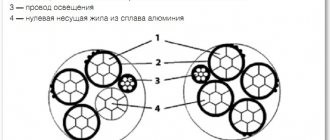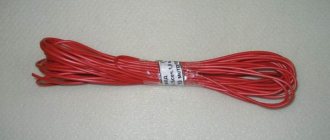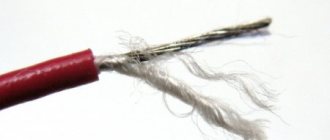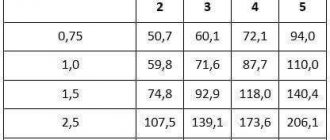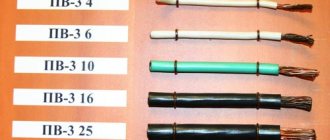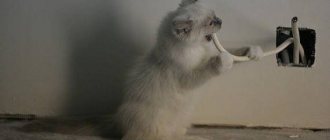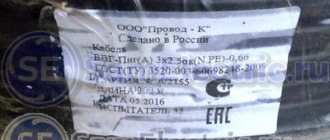Heat-resistant wire is a special type of cable and wire products that is resistant to adverse factors. Its peculiarity is the presence of additional insulation - a special winding made of non-flammable material. The use of such a wire is allowed even under conditions of exposure to high temperatures, high humidity and contact with aggressive environments. Area of operation: baths, saunas, industrial premises, hot shops and other places where the use of ordinary wire without protection is unsafe. Depending on the type of model chosen, the wire has different thermal resistance characteristics. You need to select a product taking into account the operating conditions.
Scope of use
PVS cable
The main places where PRKS is used are where it is unacceptable to use wiring without special protective insulation: there are high temperatures, there is the possibility of mechanical or biological effects on the wire, there is high humidity, as well as other “unfavorable” operating conditions. All capabilities of the wire are specified in the documents on the basis of which it was produced.
PRKS wire in the bath
Often the cable is used to connect and connect parts of electric stoves and ovens, electric fireplaces and stoves. In baths and saunas this cable is simply irreplaceable. In addition, it can also be used in hot production shops, laundries and basements.
Today, the production of PRKS of various colors has been established, including “wood” ones - especially for wooden buildings in which it is undesirable to highlight the electrical wiring with color.
Thus, PRKS is a universal cable for transmitting electrical power from the distribution board to the end consumer, both in industry and in private households. The presence of various colors of its external insulating material is sure to satisfy even the most demanding customer.
Subtleties of design
RKGM is manufactured in strict accordance with the current TU16.K80-09-90. The wire is single-core, made of copper, has flexibility from the fourth class according to the GOST 22483-77 classification.
The current documents document the correspondence of the core cross-section (nominal parameter) with the actual wire cross-section. For example, the thickness of a core per “square” is 0.31 mm. This means that the wire must contain three or more wires.
RKGM elements:
- INSULATION. Above the copper core there is a special insulating layer made using organosilicon rubber. Today the material has a simpler name - silicone rubber or SiR. The advantage of RKGM insulation is its high level of flexibility, resistance to high temperatures and stretching. To make heat-resistant wire, a composition is used that maintains parameters over a wide temperature range - up to 200 degrees Celsius or more. Today, silicone insulation is actively used for special fire protection wires that can withstand high temperatures up to 950 degrees Celsius. The insulation thickness varies according to the rated voltage.
- OUTER SHELL. On the surface of the product there is a braid made of special threads with a fiberglass structure and impregnated with a special type of varnish KO-921. This approach guarantees high fire resistance and increased strength. This type of varnish includes a glyphthalic composition and silicone resins. The use of impregnation guarantees the resistance of the wire to high temperatures (up to 250 degrees Celsius). In general, the cable insulation belongs to class H according to GOST 8865-93 and successfully withstands temperatures of 180 degrees Celsius.
This combination makes the heat-resistant wire RKGM an invariable assistant in situations where flexibility, unpretentiousness and the ability to work in a wide temperature range are required.
Description of the RKGM cable
Characteristics of heat-resistant wire PRKA
Like prks brand products, these wires belong to the category of heat-resistant cable products, but have a number of differences in structure. PRKA is a single-core cable; this characteristic is not even indicated in the marking, since all PRKA contain one core by default. Prx cable, on the contrary, is also available in multi-core versions. These are the options that are most in demand among buyers.
Important! Temperature-resistant products of the PRKA and PRKS brands are produced not according to state standards, but according to technical specifications. For the first of them this is standard 16-505.317-76, for the second - 16 K71-379-2007 or TU16.K138-001-2006
Sections
PRKA type products are available in the following cross-sections: 0.5, 0.75, 1, 1.5 and 2.5 mm2. For all of them, with the exception of the last one, the insulating layer has a thickness of 0.6 mm (for a core cross-section of 2.5 mm2 it is 0.8 mm).
Important! The maximum deviation of the insulation thickness downward will be 10%. For the most part, this parameter is not strictly regulated.
PRKS products, on the contrary, are produced in an assortment of designs with the number of cores from one to five, and each of the core elements includes a plurality of wire pieces. Thus, this wire has a more complex structure. The thinnest core options have a cross-section of 0.75 square millimeters, the thickest - 16. When a three-phase consumer is connected to the electrical network using such a cable, the wire can withstand loads of up to 45 kilowatts.
Since a wide range of possible cross-sections of cores and their number in one cable gives a significant range of design options, different types of RPKS are subject to different design restrictions associated with operation at a certain voltage value:
- For wires designed for operation at a rated voltage of 380 V, the thickness of the insulating layer for conductors with a cross-section of 0.75-1.5 mm2 should be 0.6 mm, for conductor elements with a cross-section of 2.5-6 mm2 - 0.8 mm, for the thickest versions with a cross-section of 10 and 16 mm2, it is equal to one millimeter.
- A voltage of 660 V requires a larger insulation thickness: for thin conductors of 0.75-1.5 mm2 it will be equal to 0.8 mm, for medium ones (2.5-6 mm2) - 1 mm, thick conductors are supposed to have an insulating layer of 1.2 mm.
- The thickness of the shell itself does not depend on the operating voltage and is determined only by the cross-sectional parameter of the core elements. For the thinnest group of cores it is equal to a millimeter, for options of 2.5-6 mm2 - 1.1 m, for cores with a cross section of 10 and 16 mm2 - 1.2 mm.
PRKS section
Design features
Heat resistant cable
Heat-resistant cable PRKS can be produced in both single-core and multi-core versions. The maximum number of core components that can be recycled for the production of a product is 5 pieces. Each of them includes a large number of wire pieces. The veins are united under one shell. The wire has a circular cross-section in diameter.
Important! The shell itself, as well as the coatings of individual core parts, is made of silicone rubber. State standard IEC 60245-3-97 contains a description of the requirements for conductor connecting products coated with this type of rubber material. Such rubber is very widely used in the production of wires that need to be resistant to high-temperature environments.
Nominal outer diameter for versions with different numbers and diameters of cores, designed for different voltages
Application area
The description of the PRKS wire tells us that its technical characteristics and design make it possible to lay wiring to lighting fixtures, sockets and for direct power supply to electrical appliances in conditions of high humidity and temperature. This is its main purpose.
In practice, it has found application in electrical installations in bathhouses, kitchens, brewhouses and other premises, as well as for connecting heating installations, for example, electric ovens, heating cabinets, dryers, electric grills.
Wire
At the same time, there are no regulatory documents limiting its use for stationary or non-stationary connection of electrical receivers, and its service life of 25 years indicates that its use for electrical wiring is justified.
PRKS cable
Home / Product catalog / Wires / PRKS
- Description
- Sections
- Analogs
- Popular
Decoding of the wire PRKS:P - Wire RK - Insulation made of silicon-organic rubber C - Connecting
Design elements of the PRKS wire:
Heat-resistant wire with copper conductors, insulation and sheath made of silicon-organic rubber.
Operating conditions for the PRKS wire:
The wire is intended for internal installation of electrical wiring of baths, saunas, connection of heating units, electric furnaces, thermal cabinets, dryers, electric grills and other devices for voltages up to 380 V AC with a frequency of 50 Hz. The wire is intended for operation at ambient temperatures from minus 50 to 180°C and relative humidity up to 98%. The bending radius during installation is at least 4 outer diameters of the wire. The wire does not propagate combustion, has low smoke generation and low corrosiveness of gas release products during combustion and smoldering. The wire can be manufactured in an oil and petrol resistant design. The wire complies with TU16.K138-001-2006.
Technical characteristics of the PRKS wire:
Flexibility class of conductors is 3.
The service life of the wire is at least 25 years.
Sections
- PRKS 2×10
- PRKS 2×4
- PRKS 2×6
- PRKS 2x0.75
- PRKS 2x1
- PRKS 2x1.5
- PRKS 2x2.5
- PRKS 3×10
- PRKS 3×4
- PRKS 3×6
- PRKS 3x0.75
- PRKS 3x1
- PRKS 3x1.5
- PRKS 3x2.5
- PRKS 4×10
- PRKS 4×4
- PRKS 4×6
- PRKS 4x0.75
- PRKS 4x1
- PRKS 4x1.5
- PRKS 4x2.5
- PRKS 5×10
- PRKS 5×4
- PRKS 5×6
- PRKS 5x0.75
- PRKS 5x1
- PRKS 5x1.5
- PRKS 5x2.5
www.rucabel.ru
Main settings
Here are the main technical characteristics of the PRKA wire:
- TU 16-505.317-76 (conductor production is regulated by standard 26445 – 85).
- Number of cores: one (not indicated during marking, since one core is used in all PRCAs by default).
- The minimum wire cross-section is 0.5 mm2, the maximum is 2.5 mm2. Next, a more detailed table of cross sections will be presented, including weight and possible dimensions (all parameters are nominal).
| Core cross-section, mm2 | Insulation thickness (radial), mm | Outer diameter, mm | Mass of one kilometer, kg |
| 0,5 | 0,6 | 2,1 | 8,7 |
| 0,75 | 0,6 | 2,3 | 11,6 |
| 1,0 | 0,6 | 2,5 | 14,0 |
| 1,5 | 0,6 | 2,8 | 19,5 |
| 2,5 | 0,8 | 3,7 | 30,3 |
It is important to know! The lower limit deviation from the shell thickness is ten percent. The value of the upper deviation is a non-standardized value, however, it is not recommended that the outer diameter exceed the maximum deviation
In turn, the upper limit deviation from the outer diameter is twenty percent. There is no normalization of the lower limit deviation.
In addition to the above, it is important to note the following technical characteristics:
- the ambient temperature in which this wire can be used ranges from +180°C to -60°C;
- maximum operating temperature: +180°C;
- PRKA can be operated at 98% air humidity at a temperature of 35° C;
- alternating current, frequency 50 Hertz, operating voltage 660 V;
- test alternating voltage with a frequency of 50 Hertz (for five minutes) - 2500 Volts;
- pulse voltage - from 4 to 5.6 thousand volts;
- insulation resistance is at least 100 MOM*km;
- construction length of wire from 200 m;
- has the following important properties: retains its shape, is elastic, resilient, very durable, with a bending radius of 2 outer diameters;
- PRKA insulation is resistant to crushing, and is also not afraid of mold;
- the wire does not propagate combustion, has low smoke and gas emissions, and is therefore resistant to ozone and solar radiation;
- service life - more than 10 years.
- Installation can be carried out at an air temperature of at least -15°C.
This wire is produced by no single manufacturer; if desired, you can find many such manufacturers
Meanwhile, almost every factory is ready to provide a guarantee for the use of the conductor for one and a half years, which is important. We talked about the best cable manufacturers in Russia in a separate article
Prx cable
02/14/2014 10:48 Lukin Alexey (Prorab)
Not long ago, a new wire appeared on the market, which was initially intended to be used mainly in industrial facilities, but due to certain properties it is becoming increasingly popular among electricians working with household electrical wiring. We are talking about the PRKS wire. Its main component has not been modernized (and how can you modernize a chemical element called “Copper”?), but the insulation and shell are made of a fairly new (for this area) material.
Technical characteristics of the wire PRKS
The most common types of PRKS wire:
PRKS 2 x 0.75; PRKS 2 x 1; PRKS 2 x 1.5; PRKS 2 x 2.5; PRKS 2 x 4; PRKS 2 x 6;
PRKS 3 x 0.75; PRKS 3 x 1; PRKS 3 x 1.5; PRKS 3 x 2.5; PRKS 3 x 4; PRKS 3 x 6;
PRKS 4 x 0.75; PRKS 4 x 1; PRKS 4 x 1.5; PRKS 4 x 2.5; PRKS 4 x 4; PRKS 4 x 6.
The first number in the name indicates the number of cores, the second - the cross-section of each core. Wires with five cores are also produced; in addition, for any number of cores, there is a wire with a cross-section of 10 mm², however, it is quite difficult to classify it as household. The color of the insulation is traditionally different, while in any design there should always be one blue (or cyan) wire, it is always set to zero by default, in wires with three or more cores there is also a yellow-green (ground), although options are possible here : Either completely yellow or completely green.
So, the main feature of the PRKS wire is the insulation and sheath. They are usually made of PVC or rubber, or both. Here the case is a little different - both the outer shell and the insulation of the cores themselves are made of silicone rubber (in everyday life - simply silicone) rubber. What does this give? Firstly, flexibility and ductility - the wire (core) itself in the PRKS is multi-wire and can bend in any way, even the third class of flexibility. And silicone insulation in this case is not a hindrance to the wire at all - it bends just as easily without deforming due to its plasticity, does not tear and does not even form microcracks. However, I think everyone has long known that silicone is not only a source for improving female secondary sexual characteristics, but also a material widely used everywhere, and everyone knows what its properties are, at least in terms of tightness and flexibility.
But this is not the main advantage of silicone insulation. The main thing is that its operating temperature is up to 180°C! Agree, it’s quite solid compared to the usual 60 – 70°C for most other wires and cables. That is, this wire can certainly be considered one of the most fire-resistant - it does not support or spread combustion. Some companies that produce it (for example, Podolsk SPKB Techno) can, upon request, make fire-resistant wire with a resistance of up to 250°C, which is even cooler. Also, the wire functions normally at a temperature of -50°C, that is, it does not lose its properties, including flexibility. Consequently, the PRKS wire is not only fire-resistant (not quite a scientific term, but quite appropriate), but also frost-resistant. Two in one, as they say.
Scope of application of the PRKS wire
The initial area of application of the PRKS wire is the installation of electrical wiring in rooms with elevated temperatures, such as brewhouses, baths, saunas and others. But in principle, this wire can be used to connect almost all household appliances (initially the PRKS wire is a connecting wire, that is, essentially a cord), but in truth, nothing prevents you from making stationary electrical wiring with its help. It is one of the safest wires used in everyday life: flexible, fire-resistant, if necessary, oil-resistant (for rubber this is critical), it works normally at an air humidity of 98% and, most importantly, unlike most connecting wires, its service life is not 6, but whole 25 years. In principle, it can be called a full-fledged cable, but that’s not for me to decide.
You can calculate the required cross-section using the PUE table on the main page of the section.
*****
Heat-resistant cable PRKS
Purpose: Heat-resistant cable PRKS with a cross-section of 0.75 sq. mm is intended for connecting electric stoves and lamps in steam saunas (baths).
Technical characteristics: PRKS power flexible cable with conductive conductors made of copper of increased flexibility, not lower than class 4. The PRKS cable insulation is a sheath made of silicone rubber. The cross-section of the conductor of this cable for saunas and baths is 0.75 square meters. mm
The PRKS bath cable operates within permissible temperatures from – 60 to + 180 degrees. C and relative humidity up to 98%.
Distinctive features: The PRKS cable does not propagate combustion, has low gas and smoke emissions, is resistant to crushing, resistant to mold, ozone-resistant, and environmentally friendly. This allows the PRKS cable to be used in the food, medical, cosmetic and many other industries, in rooms with high humidity and temperature (for example, inside the steam rooms of a Russian bath and Finnish sauna). PRKS is available in cross-sections from 0.75 to 10 square meters. mm, with a number of cores from two to five of different insulation colors.
The service life of the PRKS cable is at least 25 years from the date of manufacture (provided the consumer complies with the rules of transportation, storage, installation and operation).
Heat-resistant cable PRKS, two-core with a core cross-section of 0.75 sq. mm, according to its characteristics, it is ideal for internal installation of electrical wiring of bath lamps and other electrical equipment exposed to elevated temperatures in the steam room of a Finnish sauna (Russian bath).
Heat-resistant cable PRKS, three-core with a core cross-section of 0.75 sq. mm, its parameters are ideal for internal installation of electrical wiring for bath lamps and sauna stoves.
*****
Heat-resistant cable PRKS
PRKS is a heat-resistant wire (copper wire with insulation and a sheath of silicon-organic rubber connecting), used for installing electrical wiring for baths, saunas, connecting various heating installations, electric ovens, heating cabinets, dryers, electric grills and other devices exposed to elevated temperatures.
In comparison with cables, wires in PVC and rubber insulation, the operating temperature of which is up to +70°C.
The PRKS wire operates within permissible temperatures from -50 to +180°C, and relative humidity up to 98%.
The PRKS wire has insulation and a sheath made of silicone rubber, which does not contain halogens, does not propagate combustion, has low smoke and gas emissions, and is environmentally friendly, which allows it to be used in the food, medical, cosmetic and many other industries, in rooms with high humidity and temperature , especially dangerous areas. The variety of cross-sections of the PRKS allows it to be used to connect devices with a power of up to 30 kW.
The wire is produced with a cross-section from 0.5 to 50.00 mm2. with the number of cores from 2 to 19 with insulation colors.
PRKS has class III conductor flexibility, with a bending radius equal to 4 times the cable diameter, and does not lose its ductility at low temperatures, ensuring ease of installation.
Based on preliminary requests, it is possible to produce PRKS of various core flexibility classes, in an oil and petrol resistant design with temperatures up to +250°C. Under critical operating conditions, when the temperature and humidity of the environment can change many times in a short period of time, the insulation and sheath of the wire are not subject to aging and do not lose their electromechanical properties.
Subject to operating conditions, the service life of the wire is at least 25 years.
The wire has already found wide application in the installation of electrical equipment in cement factories, in the installation of dryers and electric stoves, and in saunas.
We hope that our proposal will not go unnoticed and will arouse interest among you and your colleagues.
*****
PRKS wire
Product code: 115576 -00001
All products supplied by us comply with the requirements of regulatory documents of the Russian Federation (GOST R, OST, TU), which is confirmed by the presence of Certificates (declarations) of quality and fire safety, as well as quality passports.
All products are covered by manufacturer's warranties, subject to compliance with the rules of transportation, storage, installation and operation.
We insure cargo in the company of a reliable insurance partner. This gives clients an additional guarantee of transportation safety and compensation in case of unforeseen situations.
As a dealer and official partner of Russian factories, we offer customers high-quality, certified products at competitive prices.
Every day, more than 200 warehouses provide us with information about the availability of finished electrical products. We know where to buy cheaper!
- - pick up
- - our delivery
- - transport company
Legal entities
Buy PRKS wire
Our company supplies PRKS wire wholesale and retail throughout Russia. We sell from stock, from the warehouse closest to you, or on order for production. You can leave a request in any convenient way: on the website, send by email, or request feedback from the manager. In the shortest possible time, he will prepare for you a profitable commercial offer, possible discounts and select the optimal delivery conditions.
PRKS wire price per meter:
The cost of products is calculated individually, based on the volume and order conditions. To find out the final price, you must leave a request.
Decoding of the PRKS wire:
P — ProvodRK — Insulation made of silicon-organic rubber
C - Connecting
Design elements of the PRKS wire:
Heat-resistant wire with copper conductors, insulation and sheath made of silicon-organic rubber.
Operating conditions for the PRKS wire:
The wire is intended for internal installation of electrical wiring of baths, saunas, connection of heating units, electric furnaces, thermal cabinets, dryers, electric grills and other devices for voltage up to 380 V AC with a frequency of 50 Hz. The wire is intended for operation at ambient temperatures from minus 50 to 180 ° C and relative humidity up to 98%. The bending radius during installation is at least 4 outer diameters of the wire. The wire does not propagate combustion, has low smoke formation and low corrosiveness of gas release products during combustion and smoldering. The wire can be manufactured in an oil and petrol resistant design.
The wire complies with TU16.K138-001-2006.
Technical characteristics of the PRKS wire:
Flexibility class of current-carrying conductors is 3. Wire service life is at least 25 years.
Manufacturers of PRKS wire:
* Manufacturing plants may not produce all cable sizes/modifications.
*****
PRKS wire
Certificates and passports
* Preliminary price for wholesale orders. Prices and availability indicated on the website are not a public offer. The price depends on the quantity, manufacturer and timing of the ordered products. To clarify the price and availability in your city, please contact our managers by phone 8-800-555-88-72
Heat-resistant cable PRKS is used for fixed installation to connect lighting, electric furnaces, electrical cabinets, stoves and other electrical heating equipment. The PRKS cable is also actively used to conduct electricity in baths and saunas. (see article cable for saunas, baths). Heat-resistant wire PRKS is available with a different number of cores, which allows it to be used to connect devices with a power of up to 30 kW. It is possible to modify the PRKS wire with oil and petrol resistant insulation.
- for connection in places with elevated temperatures (baths)
- for connecting electric heating devices
- in places with increased fire safety requirements
PRKS cable design elements
- current-carrying conductor twisted from copper wires (flexibility class 3) with a total cross-section from 0.75 to 50 mm2; The number of cores is from 2 to 19.
- Silicone rubber insulation;
- Shell - silicone rubber;
Technical parameters of PRKS cable
Operating temperature, C
Certificates and guarantees
Cable Systems LLC sells only certified cable products manufactured in accordance with GOST or TU, in particular the PRKS cable (GOST 7399-97). In our assortment you can find products from different manufacturers. We work only with trusted manufacturers. Therefore, we are confident in the quality of the goods supplied.
The service life of the PRKS cable can be up to 25 years. The manufacturer's warranty period is at least 1.5 years.
The closest analogues of the PRKS cable
- PRKA - the design includes one core with flexibility class 5
PRKS cable price
The Cable Systems company always maintains competitive prices for all cable products, this also applies to the price of PRKS cable. We save your money!
To calculate the cost of your footage, send an online application or call a multi-channel phone
PRKS wire cost
Didn't find prices for the section you need? Let us know by sending an online request!
*The prices indicated on the website are not a public offer in accordance with Art. 226 of the Civil Code of the Russian Federation. To clarify prices and availability, please contact the company’s managers by phone: 8-800-555-88-72
Send a request We will select a cable to suit your requirements at the best price. Your consultant: Altyev Aziz Calls within the Russian Federation are free
Leave your contact details and we will call you back within 15 minutes.
Main office
LLC "Cable Systems"
8
ICQ 639533302 196084. St. Petersburg, st. Chernigovskaya, 8, lit. B
linochek.ru
Explanation of markings
What is the difference between a cable and a wire?
Cable models intended for installation work have names, the decoding of which can tell the consumer about the main properties of the product, the material from which it consists, and also suggest what these conductors are best used for.
If you take heat-resistant PRKS products, then the letters in their names carry the following information:
- The letter P indicates that the product belongs to the wire class. In this case, they include copper core components.
- The letter combination RK stands for “organosilicon rubber.” It is also called silicone. This is one of the common materials used as raw materials for conductor sheaths. Its features include the absence of halogen inclusions in the material. In addition, this rubber is impregnated with a special composition designed to protect against rotting and fungal attack, the threat of which appears under operating conditions conducive to this.
- The letter C indicates that this product is used to connect various circuit elements to each other. In the popular PRKA product, in some cases acceptable for use as a replacement for PKRS, the last letter of the marking does not indicate the aluminum composition, as you might think (in fact, this model also has copper veins), but the high degree of hardness of the product.
